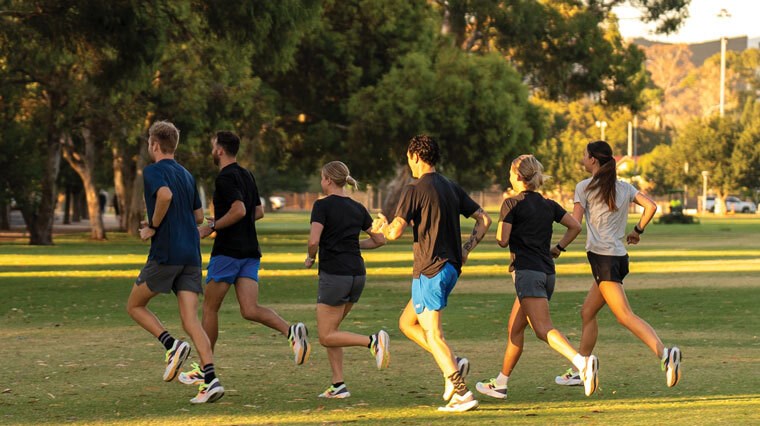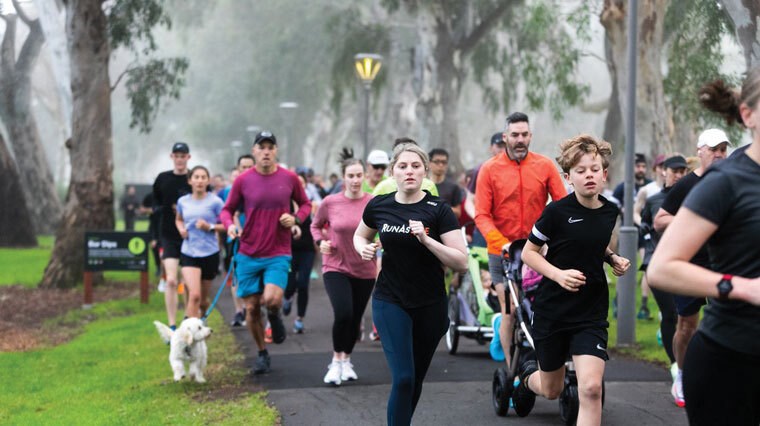How To Choose The Right Race Distance For You: 5K Runs To Marathon

The running race you register for should be personal to your specific goals, ability and the experience you wish to achieve. The beauty of an upcoming race day is that it can keep you consistent and motivated in your training.
If you’ve ever asked “What is a good running distance goal?” or “How do I find my best running distance?”, you’re a part of a community of runners seeking to put more purpose behind their training sessions.
Distance is a major factor around choosing the right race or running event for you. However, it’s not just about the distance, but the experience - the journey from training to finish line. If you’re stepping into the racing world, you may be overwhelmed by the many types of running races to choose from.
In this article, we cover the most popular road race distances – 5K, 10K, half marathon and marathon to give you expert insight on each. We’ll discuss everything from the time commitment and level of planning they require, to the unique experience they offer on race day itself.
But first, we’ll talk about you – your running goals and your ability. These are key elements when choosing a race that aligns with your motivation and level of fitness – from beginner to elite runner - to ensure race day success.
Success doesn’t mean a race run perfectly, but a race run to the best of your ability – helping you build a love of running, mental fortitude and positivity you can apply to every aspect of your life.
Your Running Ability
Beginner runners are just as capable of achieving their goal race day distance as advanced runners. Often, the difference is purely time and commitment. Using your time wisely through developing and devoting yourself to a training plan that is personalised to you means any race distance is within your reach if you commit to working toward it.
A beginner runner can become a veteran marathoner – so if you have a big dream, embrace it. The secret to turning your aspirations into reality is breaking it down into smaller steps or milestones. If running a marathon is your bucket list item – considering setting yourself up for success by training and competing in shorter events like 10K or half marathon.
Not only will this help build your stamina and running efficiency, but it'll give you real-world perspective on whether a marathon goal is right for you. By this point, you would have transitioned from being a beginner runner to an intermediate runner. Achieving these smaller goals will naturally build your confidence, self-belief and mental resilience before turning your full attention on longer endurance efforts.
People that already have a strong foundation of fitness are likely to be marathon-ready sooner than new runners, so it’s important to look at your running background (including any injuries) and starting point when choosing your race distance goal. Like anything in running, building your distance and/or speed gradually is necessary to avoid burning out, injury or putting yourself on the sidelines of your training.
Choosing the right race for your ability can often come down to motivation. If you set your goal too far in the future, it may not feel realistic or attainable. If you set a running goal that feels too easy, this can be equally as discouraging.
If you’ve already achieved a distance goal - whether a 5K or a marathon - the next motivational step may be to set a new PB for that distance to prevent a plateau in your running journey. Even if you're an advanced runner with years of experience, a 5K run can still offer a challenge if you shift the focus from distance to speed. This means your running ability is not the only aspect that defines what racing distance is right for you.
Your Running Goals & Motivation

Determining the right race distance for you begins by looking inward. What is your motivation for signing up for a race or running event? This is a truly personal question and there are no wrong answers.
Here’s are some common examples to ignite your race day enthusiasm and discover which motivation resonates with you.
- Creating new memories and enjoying new experiences
- Raising funds for charity through running
- Socialising and connecting with your running community
- Motivating you to reach your goal fitness/distance
- Adding accountability or extra commitment to your running journey
- Fuelling your passion for running
- Inspiring others like your friends and family, or to be a positive role model
- Ticking a goal off your bucket list (e.g. running a marathon)
- Striving for a personal best or continuous improvement in your performance/endurance
- To travel - enjoying races or running events across the globe to widen your perspective
- To become stronger, faster or fitter
- To stay fit and healthy as you age
- Because you love a challenge and the sense of accomplishment it provides
- Because you thrive on competition
- To top the podium (generally a goal of advanced runners/elite athletes rather than beginner runners)
- For fun
Running goals like committing to walking or jogging 5K once a week are just as legitimate as the bucket list item of running a marathon.
No matter your ability, maybe competitive racing or endurance running isn’t for you and that’s OK. There are many other running events that allow you to soak up the positive benefits of running and support your goals.
Our blog on How To Set Smart Fitness Goals can help guide your goal-setting and solidify your commitment. Keep your running event or race day motivation in mind as we discuss the common race distances below from 5K to marathon.
5K Running Events

The 5K run is the most accessible to beginners and is a valuable starting point to nurture your motivation, offering enough challenge without being overwhelming.
This is why a Couch To 5K running plan is universally popular for anybody starting their running journey. After a relatively short commitment of about 6 weeks as a guide, it is entirely achievable.
It is also the ideal distance to build upon your speed and strength down the track, if this is among your running goals. Beginners will get immediate benefits from training for a 5K in their confidence and cardiovascular fitness, while warding off health issues from depression to diabetes.
The 5K distance category can be broken up into different running event types to cater to every running goal and ability.
Fun Run
Fun runs are true to their name. In many ways, they are less about the run itself – achieving a PB or reaching the winners’ podium – and are more about the theme that coincides with them.
From vibrant coloured powder to creative costumes to obstacle courses, these fun runs not only make putting foot to pavement a positive experience that can be shared by all generations of the family, but equally as importantly, may raise awareness for worthwhile causes or charities. As such, these light-hearted, joy-inspiring events can also hold a lot of meaning behind them.
Typically, the distance of a fun run is 5K or under – encouraging participants to walk, jog or run at any pace. The key piece of running toolkit here is your smile.
Australia's favourite fun runs are often part of the country's most iconic marathon festivals, including:
- The Sydney Marathon Family Fun Run (3.5km)
- The Adelaide Marathon Festival’s 5km Fun Run
- The Gold Coast Running Festival’s 5km Fun Run
Check out 6 Must-Run Marathons In Australia to learn more about these marathon festivals.
Parkrun

If you’re looking for a pressure-free, obligation-free and cost-free running event, parkrun is for you. Held on every Saturday morning, parkrun has hundreds of locations across Australia and thousands across the globe. Run by volunteers, at the heart of the parkrun phenomenon is an uplifting sense of support and community that spans across all ages and backgrounds.
Everyone is welcome at parkrun and parkrun is for every ability. No matter your pace, no one is left behind with a volunteer Tail Walker at the end of this joyful pack of walkers, joggers and runners. This means parkrun is equally a fantastic opportunity to stretch your legs and socialise.
In fact, year in and year out the average finishing time of parkrun is increasing for participants. This is something to be celebrated, as it means more people are joining parkrun of different abilities – where participation over pace is the goal for many. Unlike a race that requires weeks of training, there isn't any time commitment for parkrun except to show up on the day.
The amazing thing about parkrun is that it truly is what you make of it. If you prefer to inject a competitive element into your parkrun and treat it as a race, that is A-OK. When you register for parkrun, you receive a unique scannable barcode ID to collect data on your finishing times. Through parkrun, you can also learn where you rank within your age category and more.
It’s also important to note that sometimes parkruns with lower popularity can present a valuable opportunity to chase down a PB, as there is less juggling with congestion. However, although it’s a timed event, it’s not technically a race.
So, whether you’re racing against yourself to achieve a personal best and the thrill of continuous improvement in your training, or want to enjoy a weekly walk-and-chat, parkrun is worth locking into your calendar.
Parkruns can be flat and fast or hilly and scenic. To get the most out of your next parkrun adventure, check out our top 5 parkruns across different Australian locations to find the right fit for you.
- The Top 5 Sydney Parkruns
- The Top 5 Adelaide Parkruns
- The Top 5 Melbourne Parkruns
- The Top 5 Gold Coast Parkruns
- The Top 5 Brisbane Parkruns
- The Top 5 Canberra Parkruns
5K Road Race
Even though the short distance 5K race has a reputation for being fantastic for new runners, it certainly doesn’t exclude more competitive athletes, no matter your ability. The shorter the distance, the less time it takes to train for and build up adequate endurance to achieve it.
In this way the 5K race offers greater flexibility than longer distances, allowing you to balance your training more easily with work and family life. You may also find you’re able to integrate cross-training into your 5K race running plan, building strength to help you become a better runner.
When training from a competitive perspective, the 5K as a shorter race gives you the opportunity to focus less on distance itself and more on athletic performance in terms of speed and your running efficiency.
10K Race
The 10K race is a mid-level distance that’s ideal to practice pacing for longer races or to enjoy in itself as a happy medium between the 5K and half marathon. This distance particularly appeals to runners at an intermediate ability level or passionate beginners. As a guide, beginner runners should set aside at least 8 - 12 weeks or longer to train for a 10K race, taking into account your starting fitness.
As you potentially climb the metaphorical distance ladder, working your way to 10K and beyond, factors such as your running nutrition, hydration and recovery play a more predominant part in your training plan. Although healthy, balanced nutrition is essential for everyone, from here you may dive into the nitty-gritty of how your sports nutrition impacts your performance.
You may also benefit from introducing tempo runs into your training when working towards the 10K race or half marathon. Tempo runs involve sustaining a comfortably challenging pace over longer distances to prepare you for endurance racing.
If you’ve conquered a 5K and feel you can push further for longer, the 10K race is a natural fit for your next running goal. Training for a 10K will both improve your speed and strength to achieve faster finish times in the 5K, as well as build upon your endurance to set your sights further to the half marathon or marathon.
Half Marathon
The half marathon distance of 21.0975km is among the most popular road race to strive for. It’s an opportunity for runners to dip their toes into the marathon scene – immersed in the crowds, the excitement and vibrant support a marathon cultivates – while being more accessible, being half the distance.
A lot of the focus of the marathon itself is simply finishing which is a spectacular achievement. However, the half marathon gives you more flexibility to fine-tune your running goals, perhaps with a focus on speed after building a solid foundation of stamina.
Alongside the beating of your footsteps will be the thump thump of running shoes from half marathon first-timers and full marathon veterans. It's a distance that brings a broad spectrum of runners with different backgrounds and abilities together.
The half marathon is an ideal milestone to work towards for runners that are visualising the full marathon distance in their future. It can also be a bucket list running goal in itself.
Whatever angle you come at it, half marathons require commitment and a focus on training and recovery in the months prior. A minimum of 12 – 16 weeks preparation is generally recommended for beginners – but as always, it’s about what is best for you and what is fitting for your abilities.
Check out these 12 (Half) Marathon Training Tips For Beginners to unlock your motivation.
Marathon

Marathons are among the most prestigious running events across the globe. At 42.195km, marathons are no easy feat. With the challenge, there is a drive that helps move participants forward to discover new levels of devotion, mental resilience and endurance. For many, completing a marathon is a life-changing experience.
A significant part of the challenge is mental – finding the inner strength to persevere when soreness and fatigue can sap you of motivation. Training for a marathon is a substantial time commitment, taking 16 - 20 weeks as a guide for most runners, or potentially 20 - 24 weeks or longer depending on your starting fitness.
During this time you won't only gradually increase the training load your heart and muscles can comfortably tolerate, but also your mental fortitude. In terms of both the physical and mental challenges, recovery such as gaining quality sleep to allow your body to repair and mind to rejuvenate is paramount.
Race day is a fun and thrilling experience, with the supportive cheers of spectators and volunteers making the power of the human spirit feel ever-present here. When running a marathon, you can feel like a celebrity as people cheer your name (if you wear it on your racing belt), no matter where you place in the pack.
It truly is exhilarating and you'll feel a sense of camaraderie with those running by your side. Marathons have the potential to bring everyone together from first-timers to elite marathoners – and it’s an amazing feeling as you run on the path of the marathon greats, like South Australia’s Jessica Stenson.
The World Marathon Majors puts some of the world’s best marathons under one name. These marathons have met stringent criteria based on their sustainability focus, mass participation, organisation and other factors, among showcasing some of the greatest cities on the globe and potentially having historical significance.
Once you’ve committed to running a marathon, the next step is to choose the right marathon for you. We’ve done a breakdown of the key elements to consider.
Qualifying Times
Some marathons have specific qualifying times, or randomly draw hopeful participants from the thousands of applications like the Tokyo Marathon. Be sure to check the specific marathon details to ensure you are eligible.
Cut-Off Times
When choosing your marathon, you may consider the cut-off time. Some marathons offer longer cut-off times to embrace inclusivity – helping runners of all abilities not only tick off a bucket list item, but to nurture a passion for running that grows long after the finish line.
With an extended race cut-off time of 7 hours, the Sydney Marathon is among them, making it an accessible choice for new marathoners.
Elevation
Alongside the distance, the elevation should be taken into account. Hilly marathons such as the Boston Marathon offer an additional element of challenge that shouldn’t be overlooked - with hill training a necessity. This can greatly influence how you prepare for your marathon compared to flatter and faster courses.
It’ll also impact your finishing time – so if speed is your priority, flatter courses like the Berlin Marathon, Chicago Marathon or Melbourne Marathon may be a better option for you.
Time Commitment
Choose a marathon that doesn’t clash with big life events like purchasing a new home, welcoming a new baby or business trips, family holidays, etc. Having a plan of your goals in the 4 - 6 months or so leading up to the marathon, can help you manage your time and stress levels so you don’t become overwhelmed as race day approaches.
Time is valuable – and finding time for marathon training can be among the dominant challenges, requiring conscious effort. It takes time to build up your training load in terms of mileage gradually and safely. Your marathon training plan must also be flexible – allowing you to prioritise recovery to avoid overuse injuries or burn out by listening to your body in the moment. Many marathon training plans commit a minimum of 3 days to rest per week – allowing your body to repair but also rejuvenating your mind.
As we touched on, the time it takes to train for a marathon is highly variant depending on your running background and current fitness level. 16 to 20 weeks is generally acceptable for most runners to condition heart, muscles and cultivate the mental resilience needed from start to finish line. If you already have a strong foundation of fitness and experience in endurance running, 12 weeks may be enough to train. If you have a sedentary lifestyle, 24 weeks or longer may be more fitting for you.
Throughout this training period, you also may integrate low-impact exercises into your routine such as cycling, swimming, yoga and weight training to allow overworked muscles to rest while building on your cardio fitness, strength or flexibility.
You must also take into account the last 2 – 3 weeks before the marathon should be used as a tapering period – reducing your training load so you can run with fresh legs on race day.
Season
Training and racing in the sweltering heat of summer will be less comfortable and require a greater focus on hydration than running in favourable conditions in spring and autumn, which may support a faster pace. Whether you’re a PB-driven marathoner or simply want to run more comfortably, the season or climate may have a significant influence on your marathon choices.
It's valuable to focus on flexibility in your marathon goals. Rather than focusing on doing your best run, focus on doing your best run for the day based on the conditions, as the temperature alongside other factors out of your control will have an impact.
The Location
You may want to put your mental resilience to the test in an iconic, international marathon like the flat and PB-friendly Tokyo marathon that celebrates the futuristic city and the power of running.
Or if you’re an Australian runner, you may prefer a cathartic experience closer to home at the Great Ocean Road Marathon in Victoria – that immerses you in enchanting coastal views, untouched rainforest and undulating hills.
The location of the marathon can inspire you – but of course, an international marathon may have its own set of challenges to consider such as your travel budget, potential language barriers, climate and the additional preparation required.
You may not run a PB if you’re sleeping in accommodation away from home, but for you it may be more about the experience and making memories over performance, which brings us to your…
Personal Marathon Goals
For some, completing a marathon may be a once-in-a-lifetime goal. For others, it’s just the starting point to clock up the kilometres for self-fulfilment and to chase spectacular goals like becoming a six star finisher.
First-time marathoners may turn into marathon veterans with the motivation to shed seconds off their personal best. For runners on a weight loss journey, training for a marathon may provide the motivation required to commit and discover a new passion for running.
A marathoner’s journey may also be inspired by raising funds for a cause close to their heart, like Tom Price’s 50 Marathons In 50 Days challenge for the Neonatal Intensive Care Unit at the Royal’s Women Hospital in Melbourne.
For more marathon inspiration, we’ve put the spotlight on some of the most epic marathons in Australia and across the globe.
Ultramarathon

We initially set out to explore the 5K to marathon road race distances - but there really is no limit to your potential through commitment, training and a positive mindset, so we’re taking this running journey further.
The ultramarathon distance is epic. Ultramarathons are generally categorised as any race longer than a marathon (42.195km). Many ultramarathons are multi-day events, potentially spanning 100km and longer.
They traverse some of the most stunning locations across the globe, with breath-taking scenery from the Madeira Island Ultra-Trail to the Swiss Canyon Trail. From tropical islands to sparse deserts, there’s an ultramarathon to awaken your senses.
If you're dreaming of your first ultramarathon, you may prefer to break that into smaller goals – building mileage by training for half marathon and marathon distances to acclimatise your body to the increased training load. However, mileage is not the only factor. City marathons won’t prepare you fully for an ultramarathon.
An ultramarathon is a completely different experience to a road race. Smooth, consistent tarmac is traded for wild, technical terrain. Not only are you conquering an enormous distance, but the nature around you offers its own, ever-changing obstacle – from climbing rocky summits, to trudging through thick mud and river crossings.
Endurance over speed is the goal here – with correct pacing essential to your ultramarathon survival. Whether you’re an ultramarathon first-timer or veteran, walking breaks are encouraged.
Preparation is everything. You’ll also have to take a close look at your nutrition strategy, as relying on energy gels alone is unlikely to sustain you during race day. Pureed or solid foods that feel more substantial may be necessary.
A significant part of completing an ultramarathon is how you fuel – providing energy without digestive upset. Both training on similar terrain to your race and testing how your gut responds to different nutrition within these conditions is a must.
Ideally, you’ll also have a support network – friends and family that are enthusiastic to travel with you, to provide nutrition and hydration at aid stations, encouraging words and even a change of running socks – which you’ll be overjoyed by if the weather takes a nasty turn.
Alike with running a marathon, your mental toughness is truly tested in the ultramarathon. A marathoner’s and ultramarathoner’s mental toolkit may include visualisation or compartmentalisation techniques, a positive mantra you can chant to yourself to float away self-doubt, and gratitude that you had the courage, commitment and physical strength to get this far and make it happen.
Check out the blogs below for guidance on everything ultramarathon – from bucket list ultramarathons across the globe, to the essential gear and nutrition you need to make your next ultramarathon a success.
- World Trail Majors: 9 Ultramarathons For Your Bucket List
- Mandatory Gear Guide: Everything You Need To Run An Ultramarathon
- Ultramarathon Nutrition & Hydration Guide: Carbs, Electrolytes & Caffeine
Happy running!
